The most recent Ligue 1 game week ended with Le Choc des Olympiques, as Lyon hosted Marseille at Groupama Stadium. This clash between two of France’s most successful clubs ended with honours even, as the teams were tied at 1-1 by the time the final whistle blew last Sunday.
Neither of these two sides have enjoyed a very positive start to the 2020/21 campaign, with Marseille winning just two of their opening six games and Lyon winning just one of their opening six games, so this past Sunday’s draw may not particularly suit either of the two sides, who will be hoping to compete for a UEFA Champions League qualification place this term.
In this tactical analysis piece, we will take a look at the tactics that both Lyon and Marseille utilised for this past weekend’s clash. We will provide analysis of how both teams set up in and out of possession in Sunday’s game and we will examine how those tactics influenced the outcome of this match.
Lineups and formations
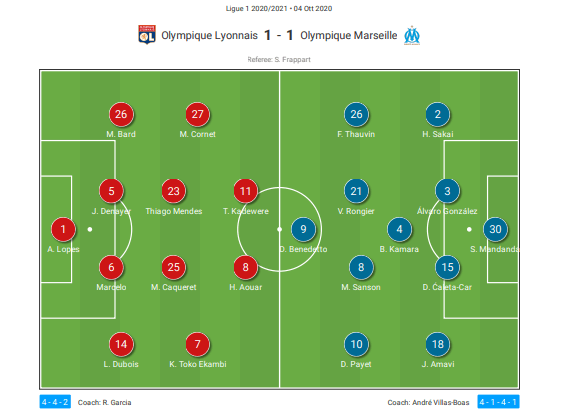
Firstly, we are going to take a look at how both of these teams lined up in Sunday’s fixture, starting with the home side.
Rudi Garcia lined his team up in a 4-4-2 shape out of possession versus Marseille, however, their shape more closely resembled a 3-2-5 most of the time when Les Gones were in possession of the ball inside the opposition half, which was quite frequently the case in this one.
Anthony Lopes started in goal for Lyon here, while a back four consisting of right-back Léo Dubois, left-back Melvin Bard and the centre-back pairing of Marcelo and Jason Denayer started in front of him.
Maxwel Cornet started at left-wing for Lyon and Karl Toko Ekambi started at left-wing, while Maxence Caqueret and Thiago Mendes paired up for Les Gones in central midfield. Lastly, Houssem Aouar, who enjoyed a fairly free role in possession of the ball, partnered Tinotenda Kadewere in Lyon’s forward line to complete this 4-4-2 out of possession.
As for the away side, Marseille captain Steve Mandanda started between the sticks for Les Olympiens here, while right-back Hiroki Sakai, left-back Jordan Amavi and the centre-back duo of Álvaro González and Duje Ćaleta Car played just in front of him.
Boubacar Kamara occupied the holding midfield position for Marseille in the 4-1-4-1 shape that André Villas-Boas sent them out in for this game, filling the gap between that back four and the midfield four which consisted of right midfielder Florian Thauvin, left midfielder Dimitri Payet and the central midfield pairing of Morgan Sanson and Valentin Rongier. Meanwhile, Darío Benedetto occupied the centre forward position for Les Olympiens.
As we will discuss at greater length in this tactical analysis piece, following Payet’s sending off in the 19th-minute of the game, Marseille switched to a 4-4-1 shape, with Kamara joining Rongier in central midfield and Sanson shifting out to left-wing.
Marseille in possession
Next, we’re going to provide some analysis of Marseille’s tactics in possession of the ball from this past Sunday’s 1-1 draw with Lyon. Marseille spent very little time in possession of the ball at Groupama Stadium, ending this clash having kept just 32% of the possession.
Even before Payet’s 19th-minute sending off, Villas-Boas’ side trailed Lyon fairly significantly in terms of possession, having kept just 41% of the ball in the opening 15 minutes of the contest.
Additionally, Marseille took just three shots in this game, hitting the target with just one of them – Payet’s 16th-minute opening goal. This indicates that Marseille were evidently efficient with their use of the ball and Payet was clinical in front of goal when given the opportunity prior to his sending off, all the while also indicating that Marseille weren’t particularly threatening in attack throughout this game.
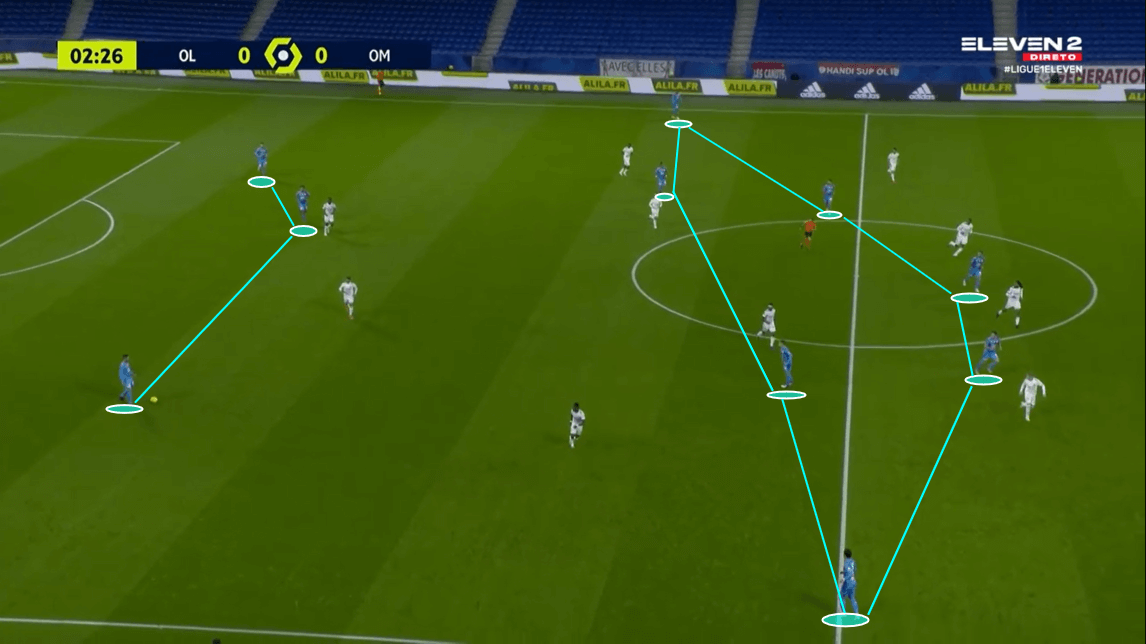
This image above, which was taken early in the first half of this fixture, shows us an example of Les Olympiens’ shape in possession of the ball with 11 men on the pitch from Sunday’s fixture.
We can see that Kamara dropped quite deep during the build-up, often sitting just in front of, or as is the case in this example, in line with the two centre-backs. This created a simple 3v2 advantage for Marseille in this early stage of the build-up, which helped them to build past Lyon’s first line of defence – Aouar and Kadewere.
Higher up the pitch, we can see Marseille’s two full-backs pushed up high on either side of the attack, essentially providing the width for their side in this early stage of the game, while Payet and Thauvin shifted into a slightly narrower position, playing just off of Benedetto.
The central midfield pairing of Sanson and Rongier also played an important role in the build-up on a few occasions for Marseille in this game, as from a position like the one we can see the away side in here, one of them would drop deeper to provide a short passing option.
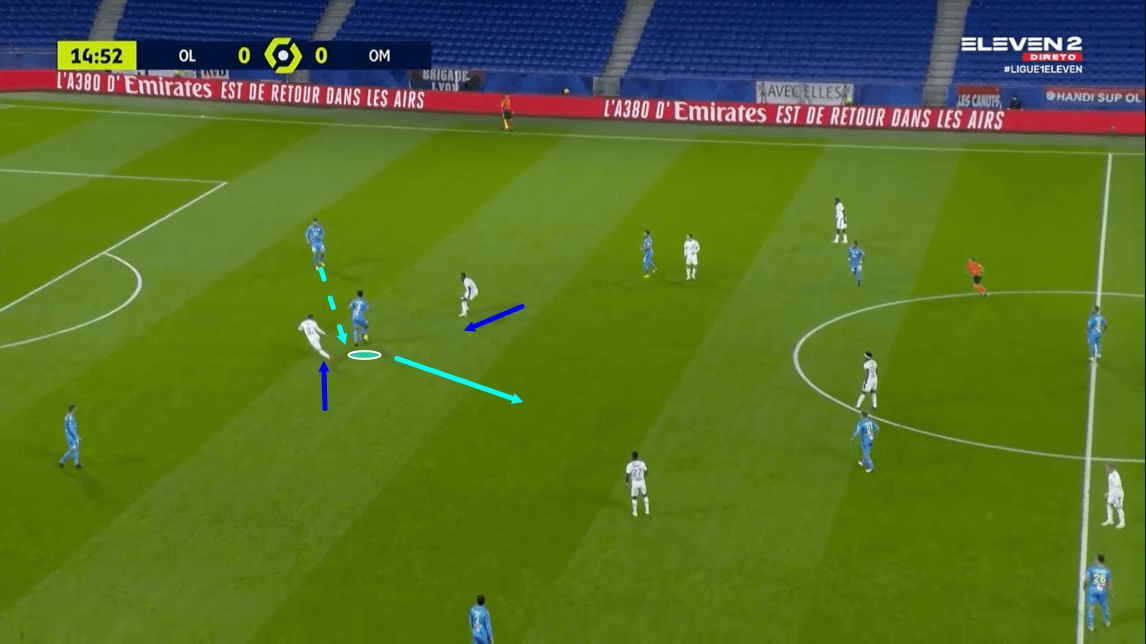
Kamara’s role in the build-up was arguably the most important during the early stages of this game, however, as a lot of the early build-up play went through him, with the 20-year-old connecting the centre-backs with the midfielders and the offensive line of five, which we have already discussed.
This next image shows us an example of Kamara collecting the ball from one of his side’s central defenders from a slightly more advanced position than the one we saw him occupying previously. As he receives this pass from the centre-back, he is under pressure from the two Lyon forwards, however, he demonstrates plenty of composure on the ball and turns under pressure from these Lyon forwards, going on to carry the ball forward towards the opposition half and breaking past the first line of pressure.
As we will discuss at greater length later on in this piece, Lyon dealt well with Kamara and limited his effectiveness in the build-up throughout the majority of this contest, as he ended up making just 18 passes in this game, which is a lower number of passes than three other Marseille players made in this contest. Additionally, he was limited to just one progressive pass in the entirety of this fixture.
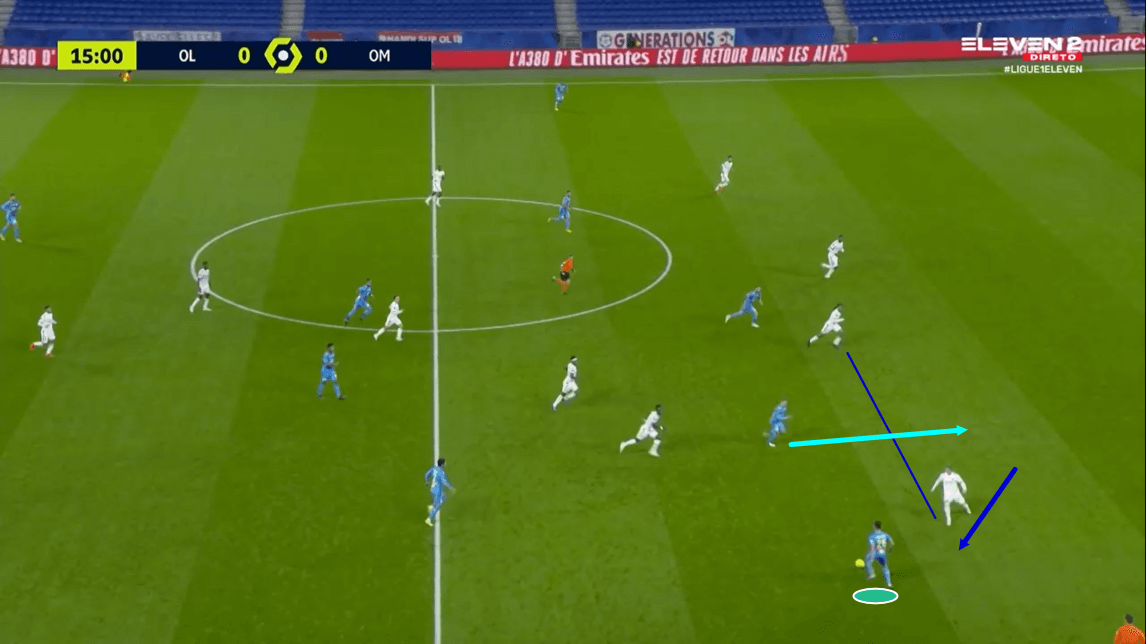
As this particular passage of play moves on, however, we see Kamara play the ball forward and it finds its way out to Thauvin on the right-wing, who then attracts pressure from 19-year-old Lyon left-back Bard.
This shows us another key element to Marseille’s attacking play from last Sunday’s game, which was there attempts to exploit this channel between the full-back and centre-back, which they successfully achieved here, thanks to Rongier’s offensive run between this gap that has been created thanks to the right-winger’s positioning.
After the ball was played through to Rongier here, Lyon managed to win it back, only for Marseille to counter-press high and win the ball back before going on to score the opening goal of the game. This attack shows us how important Kamara’s role in the build-up was and this exploitation of the gap between the full-back and centre-back was in Marseille’s attacking play.
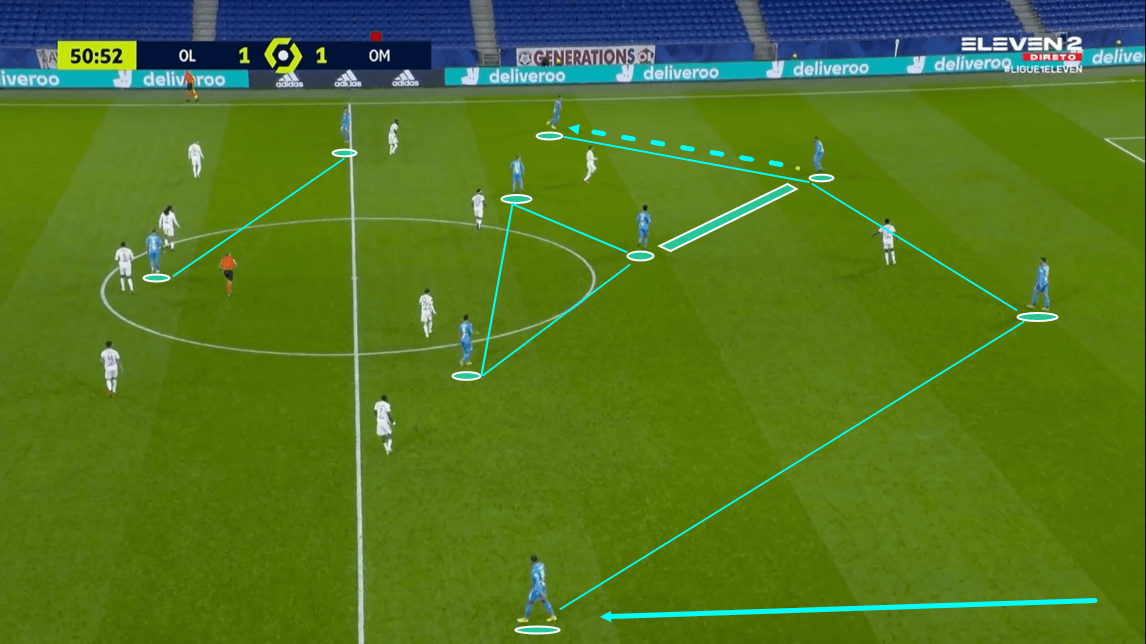
Due to Lyon’s effective defending against Kamara, again, which we will discuss at greater length later in this tactical analysis piece they built their attacks through him less and less as this game wore on, instead opting to focus their build-up and their attacks more through the wide areas, specifically the right-wing, which was likely a result of left-winger Payet being sent off, leaving that side of the pitch quiet, as this image shows us.
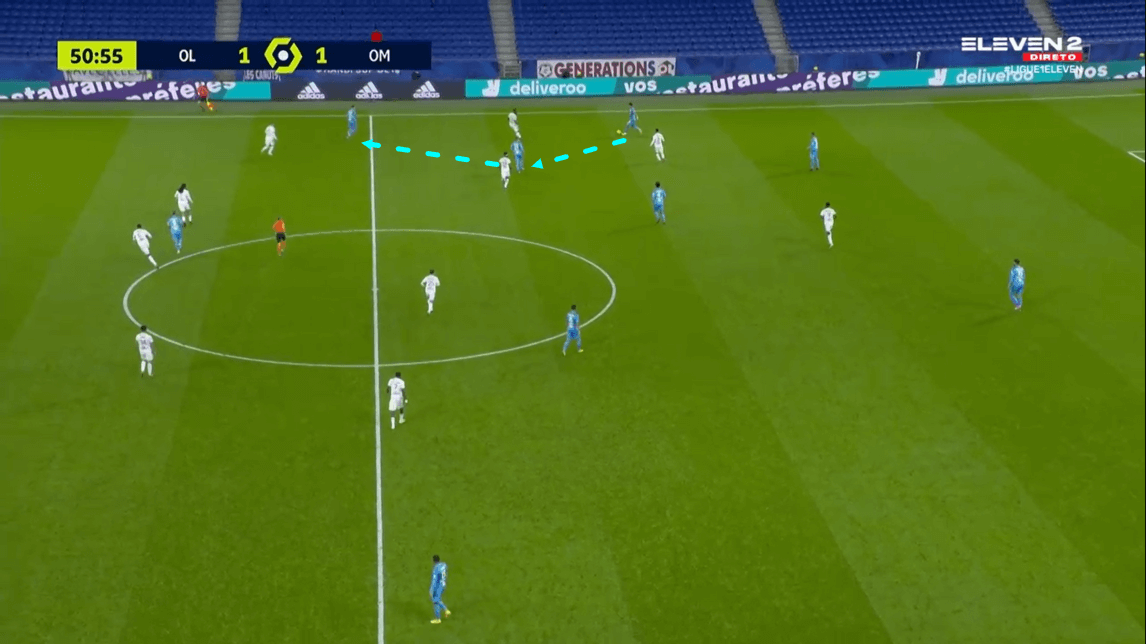
However, while their left-winger was sent off, Marseille did their best to exploit the right-wing, as this image illustrates, and a lot of their attacks in the middle-later stages of this game were built via the wings, while they also counter-attacked heavily via the wide areas.
They relied on this triangle of the right-back, the right central midfielder and the right-winger to overload this side of the pitch and combine via some quick passing plays to try and build into Lyon’s half, while Marseille also relied heavily on individual dribbling skill, particularly during counter-attacking situations, in the wide areas, however, these tactics failed to produce a great deal of trouble for Lyon, who had enough men to cover these areas and make it difficult for Marseille to play through them.
Lyon out of possession
Lyon defended much more aggressively than Marseille in this game. They ended the fixture with a PPDA (passes allowed per defensive action) of just 6.6 which is significantly lower than Marseille’s PPDA of 15.4 for this match, indicating that Lyon were the more aggressive side in terms of pressing in this game.
However, during the early stages of the game, Lyon weren’t incredibly aggressive in the press, as they had a PPDA of 21.3 for the opening 15 minutes of the contest, which was actually higher than Marseille’s PPDA of 15.7 for that stage of the game. After Payet was sent off, however, the game changed and Lyon’s pressing became much more aggressive much more consistently.
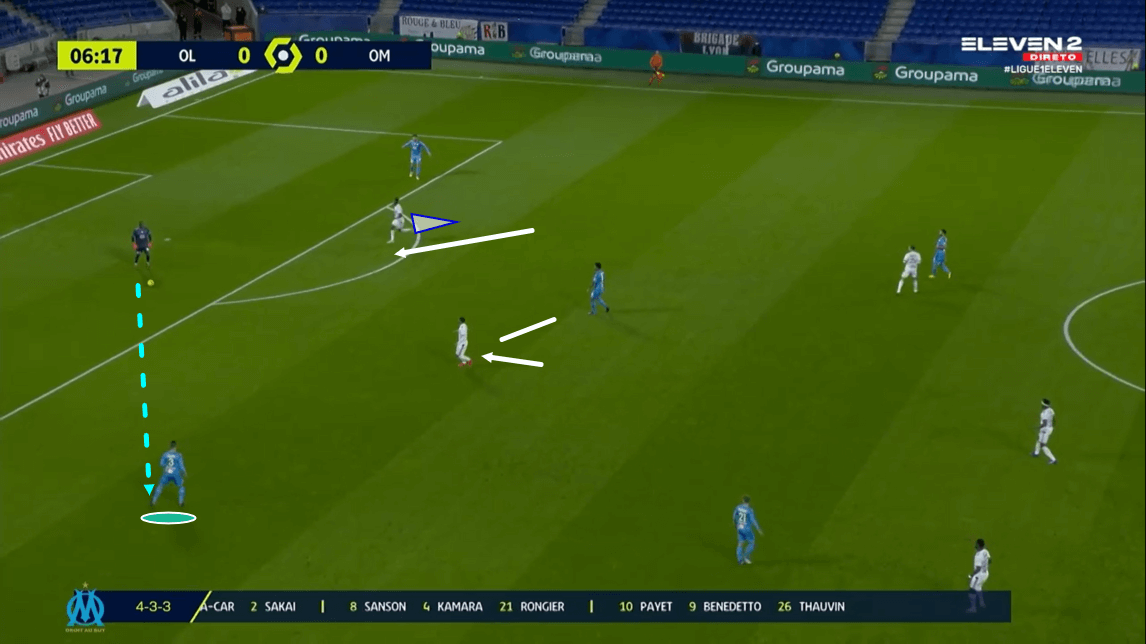
With that said, Lyon did press high in some instances early on in this game and the image above shows us an example of one such occasion, with Les Gones setting an early pressing trap to steal possession away from Kamara, as they did on a number of occasions throughout this contest and this is how the home side set up to deal with Kamara and the importance of his role in the build-up for Marseille in this game.
Here, we can see Mandanda in possession of the ball, while Kadewere is pressing him, shaping his run to block off the passing lane to Ćaleta Car, Aouar maintains access to Kamara, should Mandanda attempt to play the ball to him in the centre early.
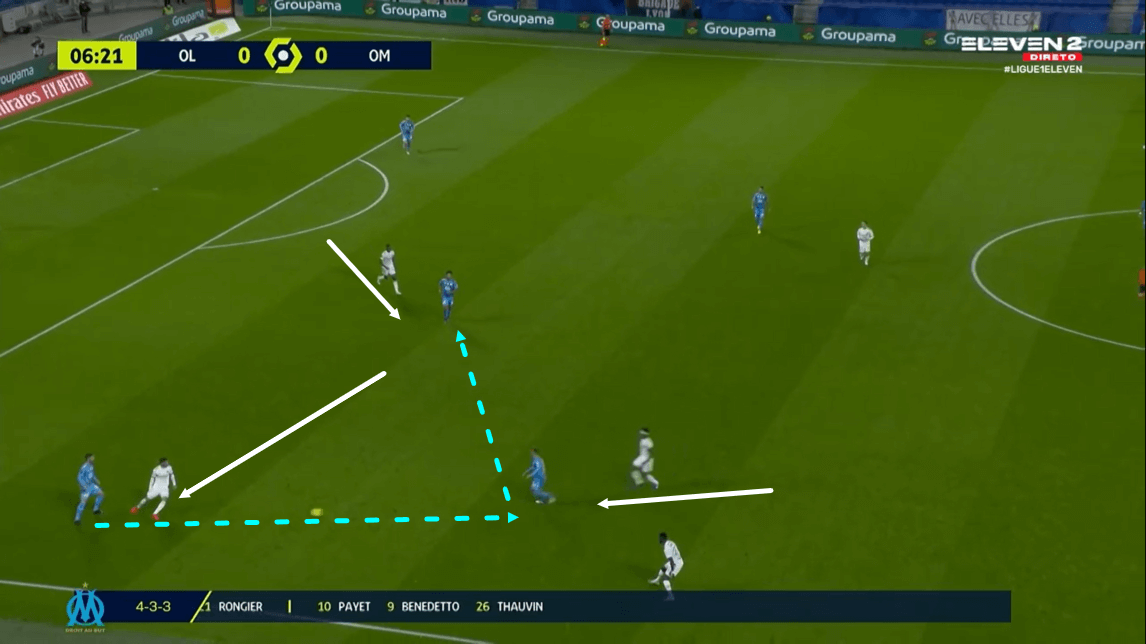
This leaves the pass to González open and he receives the ball but is immediately put under pressure by Aouar, who quickly presses the centre-back while keeping the potential pass inside to Kamara in his cover shadow, as Kadewere also drops onto Kamara from behind.
This leaves a pass into Rongier, who has dropped from his slightly more advanced position, open for González and the centre-back takes up this passing option, however, as the central midfielder is followed and prevented from turning by Lyon midfielder Mendes, he then quickly plays the ball back to holding midfielder Kamara.
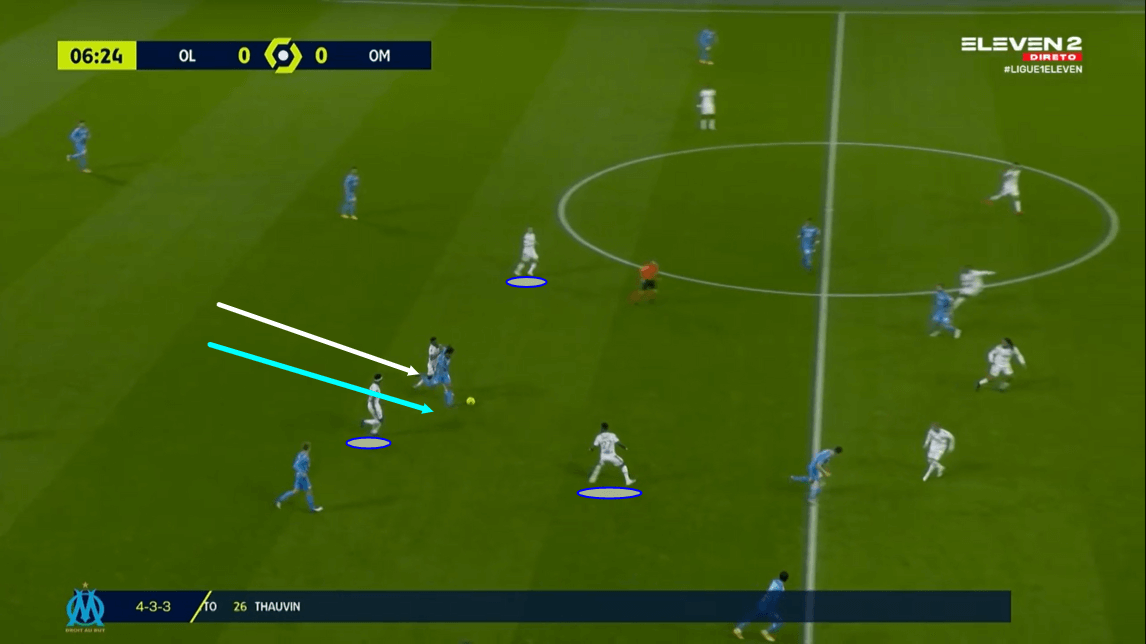
This is the pass that Les Gones had been waiting for and as Kamara receives possession, Kadewere springs into action and chases him down while he tries to carry the ball out from the back.
As this passage of play moves on, Kadewere successfully forces the turnover here and his side can then start a counter-attack from a dangerous position inside of the opposition’s half of the pitch.
Lyon sprung this pressing trap on a number of occasions when the ball was played into the Marseille holding midfielder during this fixture and it was effective at preventing him from helping his side to play through Lyon too often in this game and it was also successful at forcing Marseille to build up in alternative ways which proved to be less effective during this contest, ultimately hampering Marseille’s build-up and Kamara’s role in possession.
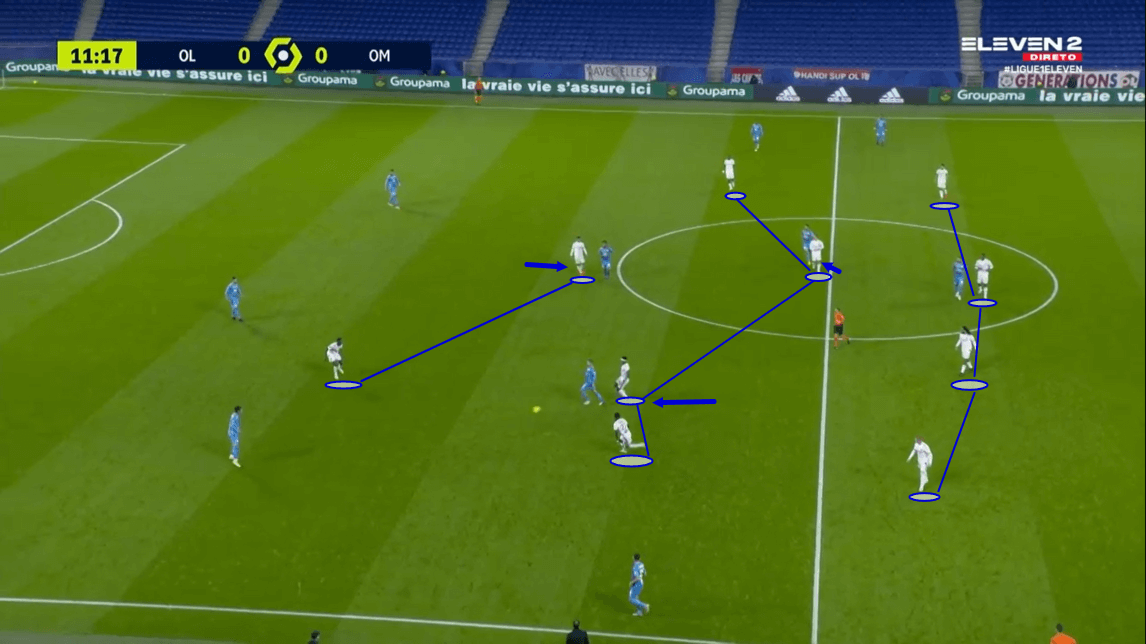
When Marseille enjoyed a sustained period of possession during the early stages of this game, Lyon set up in a 4-4-2 and marked zonally in a man-oriented system, as the image above demonstrates.
This defensive shape and system saw them defend compact and narrow, while they also played a relatively high line and tried to win the ball fairly high up the pitch, with the man-oriented nature of this system leading to Lyon’s players pressing some of Marseille’s players quite aggressively on occasion when they were occupying a position inside of their particular zone.
As this game progressed, however, it became more common to see Lyon pressing higher up the pitch to win the ball back, rather than sitting in this slightly more reserved 4-4-2 man-oriented zonal system.
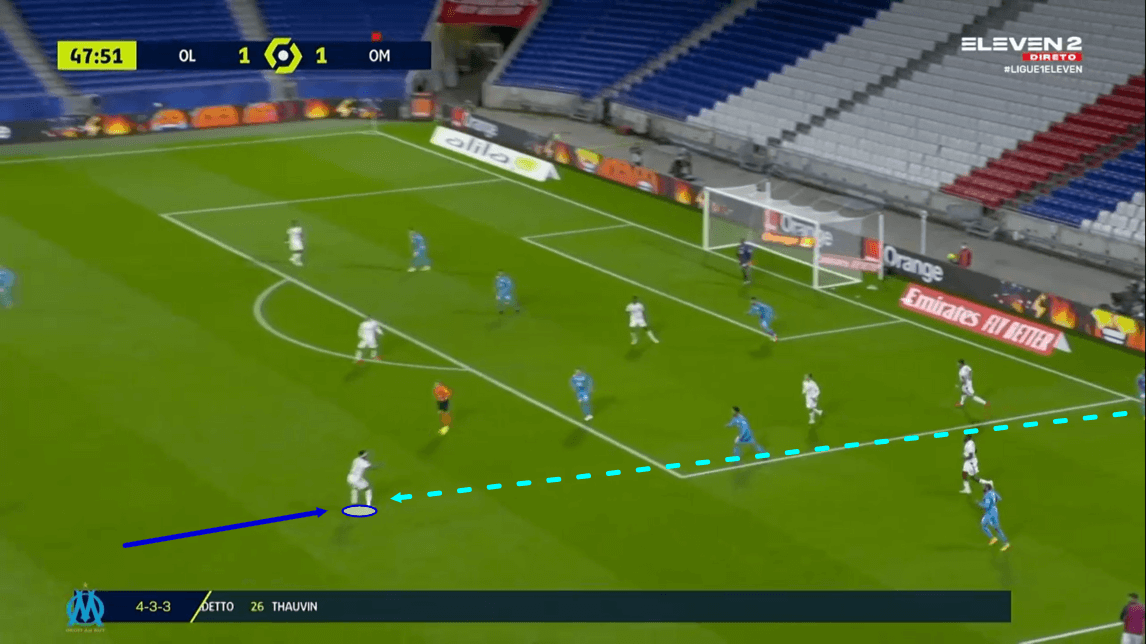
Lyon counter-pressed Marseille quite aggressively in the latter stages of the first half and during parts of the second half. The image above provides us an example of how this proved to be effective for Les Gones in this fixture.
Just prior to this image being taken, Marseille had just won the ball back from Lyon and attempted to clear it up the field, however, due to how many men Marseille had sitting deep and due to Lyon’s effective counter-pressing and effective occupation of space in and around the penalty areas and the right areas of the pitch, they managed to quickly win the ball back just outside of the opposition box.
At the end of this game, 30 of Lyon’s 66 recoveries came in the opposition half of the pitch, indicating just how effective they proved to be at pressing high and winning the ball back high up the pitch in this fixture.
Lyon in possession and Marseille out of possession
In this next section, we’ll provide some tactical analysis of both Lyon’s tactics in possession and Marseille’s tactics out of possession, together, from this past Sunday’s fixture.
In addition to ending this game with the lion’s share of the possession (68%) and having taken 24 shots to Marseille’s three, Lyon generated 3.5 xG (expected goals) last Sunday to Marseille’s xG of 0.28, indicating that the home side dominated in terms of chance quality, but were ultimately unable to convert from open play during this 90-minutes versus Marseille, with their only goal of the contest coming via a penalty.
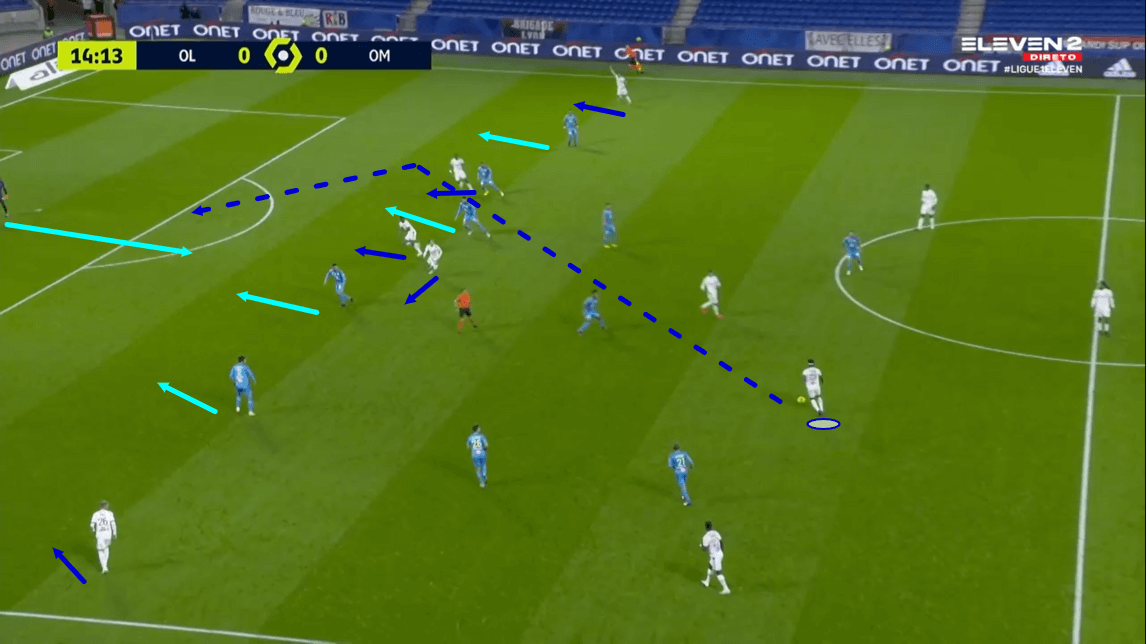
The image above provides us with an example of Marseille’s defensive shape from the start of this game, with Les Olympiens lining up in a 4-1-4-1 shape during that part of the contest.
As we can see their backline and midfield line remained very compact, allowing little space between the lines and very little space, if any at all, in the central space between the lines being occupied by Kamara. Their backline also sat relatively deep, allowing little space in behind, while Marseille didn’t press incredibly aggressively from the front in this game either.
Furthermore, Marseille’s backline were prepared for Mendes’ long-balls and were prepared to drop even deeper and chase them down. In the image above, we can see how Marseille’s backline brace themselves to deal with this long-ball by orientating their body sideways to give themselves the best chance of keeping their eye on the play, while also giving themselves a good chance of tracking back to deal with this long-ball attempt at the same time.
Despite Marseille’s backline sitting quite deep, Mendes attempted to play balls over the top on two or three occasions during this game, with all of those attempted long-balls ultimately failing to meet a Lyon player and release them in behind Marseille’s defensive line.
Given how little space there was in behind Marseille’s defensive line, it may not come as a surprise that Mendes’ long-balls over the top were unsuccessful versus Marseille and these attempted passes likely played a big part in him ending this game having hit the target with just four of his 10 attempted long-balls – the lowest long-ball accuracy percentage of any Spurs player from this game.
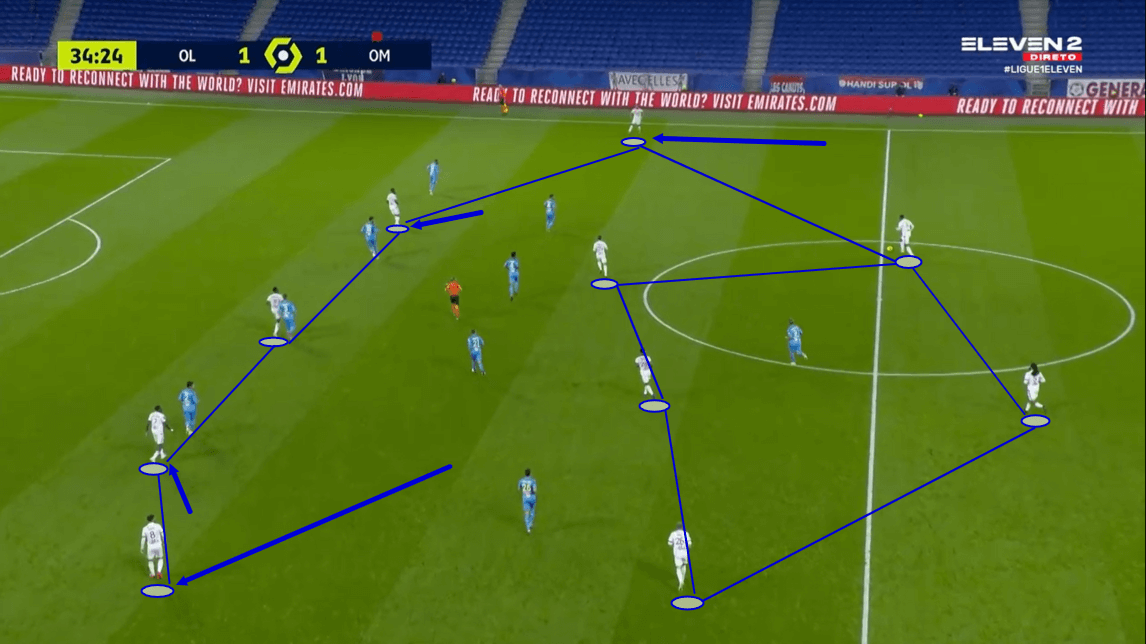
This next image shows us an example of both Lyon’s typical shape in possession from this game and Marseille’s typical shape out of possession in this game. With Payet being sent off in the 19th-minute of the game, Marseille had to switch up their shape and they changed from a 4-1-4-1 to a 4-4-1 as a result of this decision.
Marseille defended quite passively throughout the contest but they especially began to defend more passively following Payet’s sending off. Prior to that sending off, their defensive system was similar to the man-oriented zonal marking system that was deployed by Lyon in this game. However, following Payet’s red card, they seemed to be somewhat more position oriented and rarely ventured from their assigned position in this 4-4-1 shape.
They sat quite deep, very narrow and very vertically compact, which made it difficult for Lyon to play through the lines, however, the home side did still manage to do so at times and they were also given plenty of space out on the wings as a result of these defensive tactics which they managed to exploit on multiple occasions.
Meanwhile, this image also shows us Lyon’s offensive 3-2-5 shape from this game. We can see that the right-back pushed up to provide width on the right, while Aouar moved out to the left-wing from his central position to provide his side with some width. Toko Ekambi and Cornet then tucked inside to play either side of Kadewere.
However, it is also important to note that Lyon played with a fluid offensive line, meaning that as long as they created this line of five, it wasn’t particularly important which player performed which exact role.
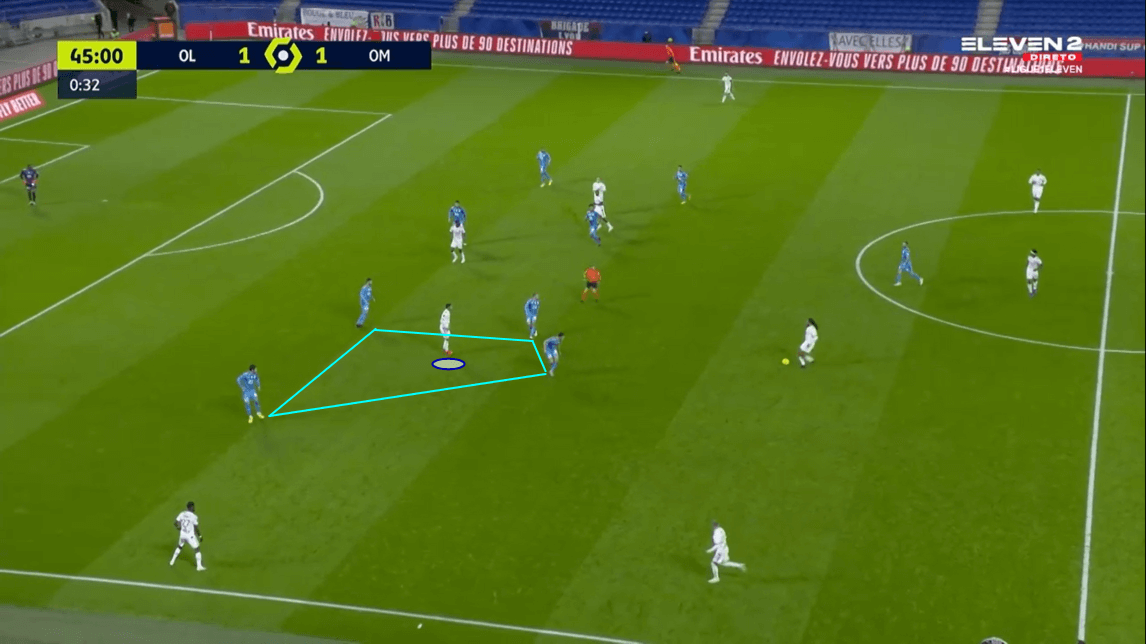
This resulted in Aouar ending up on the left-wing at times as we saw in the previous image, however, on other occasions, as the image above shows us, he occupied the left half-space, finding some space between the lines for his side between the opposition’s centre-back, full-back, central midfielder and wide midfielder. On these occasions, Cornet would stay out wide, while Aouar would simply advance his position from the left side of central midfield to the left half-space.
When picked out in this position, the 22-year-old, who had been heavily linked with a move to Arsenal over the recent transfer window, utilised his dribbling and passing quality to help his side open up Marseille and he ended up making more deep completions (four) than any other Lyon player in this contest.
Aouar’s freedom of movement in the final third also made him a difficult man for the opposition to mark and keep track of and this is another reason why he was so effective for his side in possession in this past Sunday’s game, as he was good at occupying little pockets of space between the lines where he wouldn’t be picked up by an opposition player and from where he could enjoy enough time and space to turn on the ball and either play it or carry it into an even more threatening position.
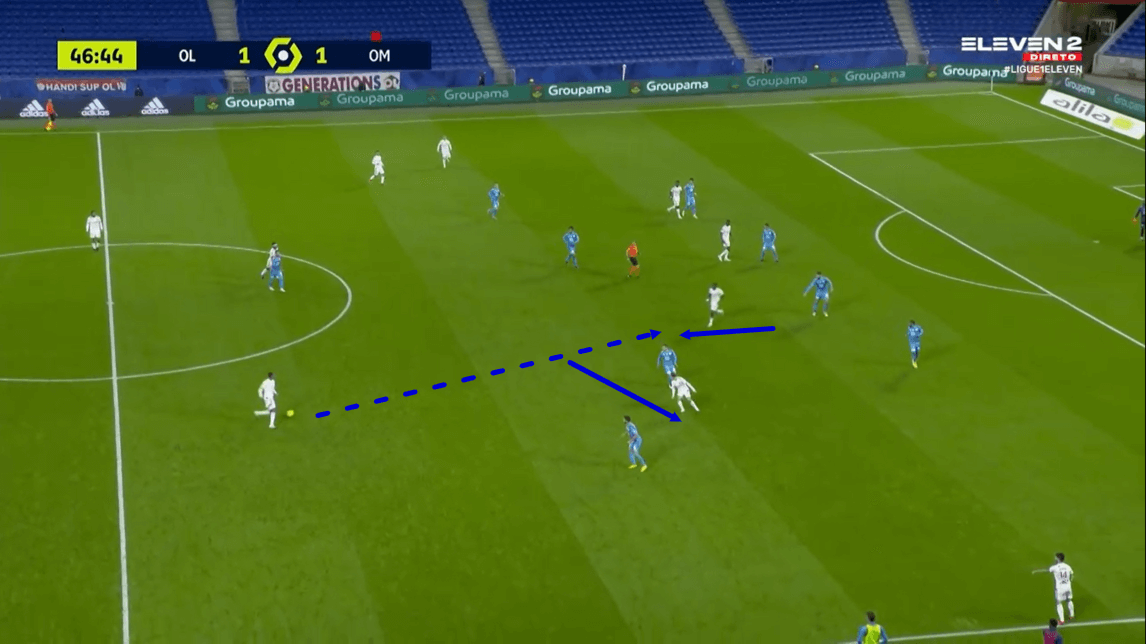
It wasn’t just Aouar who exploited the little pockets of space Lyon could find between the lines versus Marseille, as Kadewere and Toko Ekambi also dropped from their advanced, central position into a slightly more withdrawn position like the one we can see Toko Ekambi moving into in this image above, on occasion in this game when the opportunity presented itself.
Just prior to this image being taken, Caqueret drew Rongier away from the centre of the pitch with an intelligent outward run, as Marcelo is in possession of the ball here, he then takes advantage of Caqueret’s unselfish movement to spot the run of Toko Ekambi into the space that the midfielder created but the forward took advantage of.
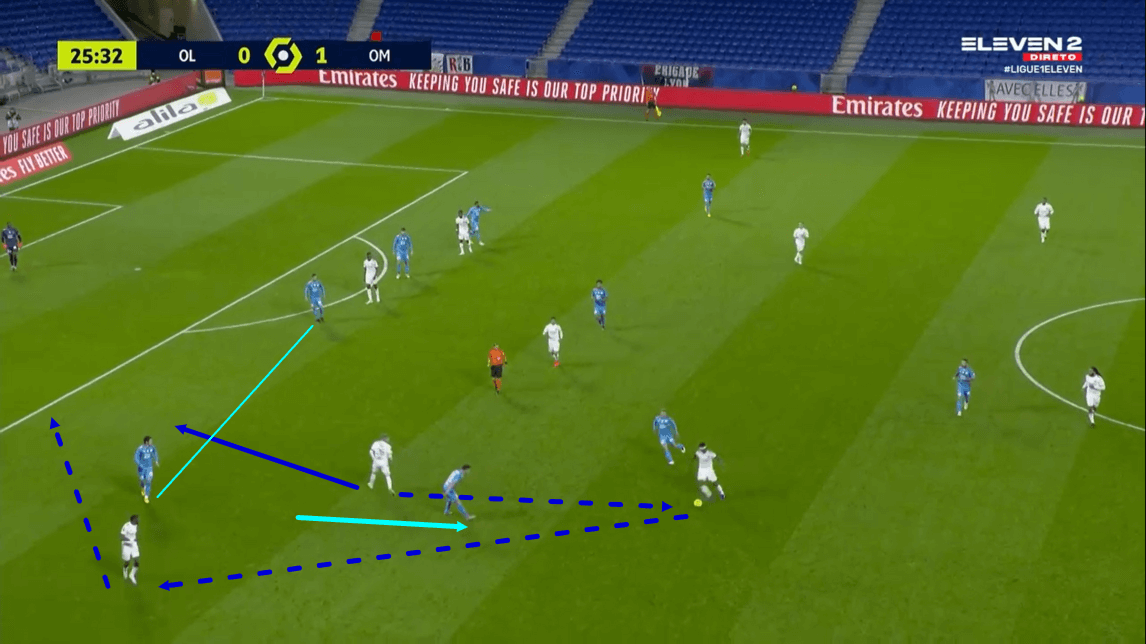
Another similarity to Lyon’s game, compared to Marseille’s game on Sunday, was how the home side also tried to exploit the space between the opposition centre-back and full-back, which we can see an example of in this image above.
Just prior to this image being taken, Lyon left-back Bard had played the ball into Mendes, who then found Cornet out on the left-wing.
However, after he played the ball to Mendes, Bard found himself essentially free in the channel between the opposition centre-back and full-back and the gap between the two players grew as Sakai pressed Cornet upon the winger receiving possession.
Bard then ran into this space, while Cornet spotted his run and played the ball through to him. As this passage of play moves on, Bard wins the penalty that led to Lyon’s only goal of the game, which indicates how crucial his intelligent movement was in this moment.
Lyon tried to force this gap to open up between the centre-backs and the full-backs throughout this past Sunday’s game and they threatened the opposition goal on a number of occasions by playing the ball through this channel, to meet runs from wingers, full-backs and central midfielders at times and it was an effective method of chance creation for them in this game.
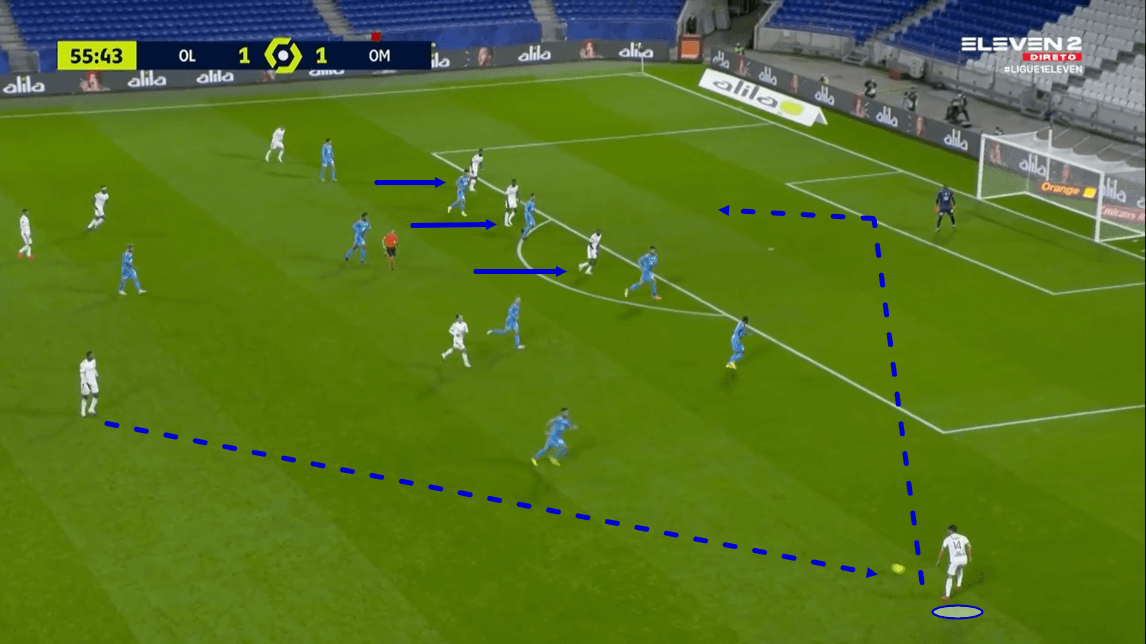
Lastly, due to how narrow Marseille defended in this game, Lyon enjoyed plenty of space out wide which the wide men, such as overlapping right-back Dubois, took advantage of and used to threaten Marseille’s goal on a number of occasions.
As we can see in the image above, 10-man Marseille’s compact block is set up to protect the central areas of the pitch but this leaves plenty of space out wide, which Dubois can then exploit via an overlapping run and a subsequent cross.
This image shows us Lyon’s trio of attackers from this game – Kadewere, Toko Ekambi and Cornet, all occupying central positions, awaiting Dubois’ cross and as this ball reaches the box, it finds the head of 183cm (6’0”) tall Kadewere – who was a major threat in the air in this game, winning three of his four aerial duels – who headed the ball just wide of the goal.
However, Marseille took a risk by allowing Lyon enough space to float a ball into the box to meet the head of Kadewere and Les Gones’ other attackers, but they ultimately did get away with it on this occasion, as Lyon didn’t score from a more traditional cross in this fixture and Marseille ended up successfully limiting Lyon to just one goal.
Conclusion
To conclude this tactical analysis piece, it is evident that Lyon came up with a number of different ways to create goalscoring chances in this one and a combination of some effective defending from Marseille, as well as an element of luck, prevented Les Gones from scoring more than one goal despite their impressive xG of 3.5 in this game.
On the other hand, it’s also clear that while they were on the back foot for the vast majority of this game, Marseille were clinical in capitalising on the goalscoring chances that they did have in this one and frustratingly for Lyon, despite all of their creative efforts, this game ended with honours even due to their inability to capitalise on their plethora of chances, in contrast to Marseille, who were far more clinical.





Comments